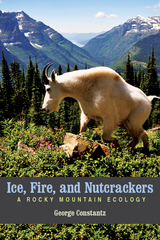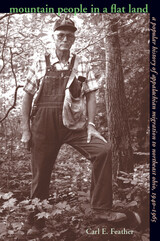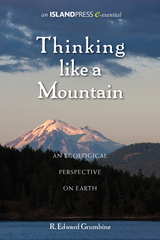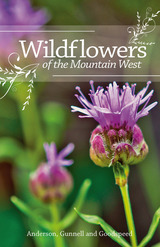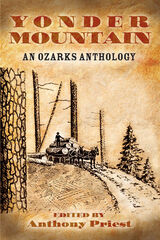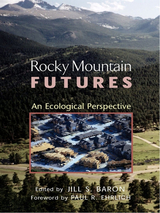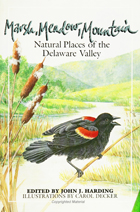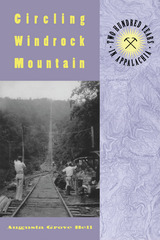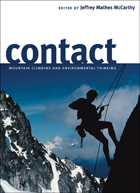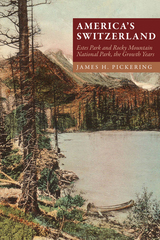MountainsCollection by Cassandra Verhaegen (11 items)The peak of literature. Includes the following tags:
Adaptation, Anecdotes, Anthologies (multiple authors), Contact, Delaware River Valley (N.Y.-Del. and N.J.), Earth, Ecological Perspective, Ecology, Effect of human beings on, Ehrlich, Paul R., Evolution (Biology), Fiction, Fire, Flowers, Grumbine, R. Edward, Guidebooks, Ice, Identification, Memoirs, Mountain, Mountain plants, Mountaineering, Mountains, Natural history, Natural Resources, Nature, Ohio, Ozark Mountains, Pennsylvania, Poetry, Rocky Mountain National Park (Colo.), Rocky Mountains, Social life and customs, Tennessee, Thinking Like, Wild flowers, Wildflowers
See More
|
Ice, Fire, and Nutcrackers
by George Constantz
University of Utah Press, 2014
Why do quaking aspens grow in prominent clumps rather than randomly scattered across the landscape? Why and how does a rufous hummingbird drop its metabolism to one-hundredth of its normal rate? Why do bull elk grow those enormous antlers? Using his experience as a biologist and ecologist, George Constantz illuminates these remarkable slices of mountain life in plain but engaging language. Whether it sketches conflict or cooperation, surprise or familiarity, each story resolves when interpreted through the theory of evolution by natural selection. These provocative accounts of birds, insects, rodents, predators, trees, and flowers are sure to stir the reader’s curiosity. Who wouldn’t be intrigued by a rattlesnake’s ability to hunt in total darkness by detecting the infrared radiation emitted by a mouse? Or how white-tailed ptarmigan thrive in their high, treeless alpine environments -- even through the winter? The narratives, often brought home with a counterintuitive twist, invite readers to make new connections and broaden perspectives of a favorite outdoor place.
1
|
Mountain People in a Flat Land
by Carl E. Feather
contributions by Stuart Hobbs Ohio University Press, 1998
In the early 1940s, $10 bought a bus ticket from Appalachia to a better job and promise of prosperity in the flatlands of northeast Ohio. A mountaineer with a strong back and will to work could find a job within twenty-four hours of arrival. But the cost of a bus ticket was more than a week's wages in a lumber camp, and the mountaineer paid dearly in loss of kin, culture, homeplace, and freedom. Numerous scholarly works have addressed this migration that brought more than one million mountaineers to Ohio alone. But Mountain People in a Flat Land is the first popular history of Appalachian migration to one community — Ashtabula County, an industrial center in the fabled “best location in the nation.” These migrants share their stories of life in Appalachia before coming north. There are tales of making moonshine, colorful family members, home remedies harvested from the wild, and life in coal company towns and lumber camps. The mountaineers explain why, despite the beauty of the mountains and the deep kinship roots, they had to leave Appalachia. Stories of their hardships, cultural clashes, assimilation, and ultimate successes in the flatland provide a moving look at an often stereotyped people.
2
|
Thinking Like a Mountain
by R. Edward Grumbine
Island Press, 2012
In Thinking Like a Mountain, we have excerpted a clear and inviting introduction to the science of conservation biology from Ed Grumbine's previous book, Ghost Bears. Grumbine offers a succinct and evocative description of why we should all care about biodiversity, protected lands, connectivity, and extinction rates, and the advantages to be gained by attempting to 'think like a mountain', as so eloquently phrased by Aldo Leopold.
3
|
Wildflowers of the Mountain West
by Richard M. Anderson, Jay Dee Gunnell and Jerry L. Goodspeed
Utah State University Press, 2012
Many recreational hikers have stopped along the trail to admire a wildflower only to wonder what, exactly, they are looking at. Wildflowers of the Mountain West is a useful field guide that makes flower identification easy for the general outdoor enthusiast.
4
|
Yonder Mountain
edited by Anthony Priest
University of Arkansas Press, 2013
Yonder Mountain, inspired by poet Miller Williams's Ozark, Ozark: A Hillside Reader, is rooted in the literary legacy of the Ozarks while reflecting the diversity and change of the region. Readers will find fresh, creative, honest voices profoundly influenced by the landscape and culture of the Ozark Mountains. Poets, novelists, columnists, and historians are represented--Donald Harington, Sara Burge, Marcus Cafagna, Art Homer, Pattiann Rogers, Miller Williams, Roy Reed, Dan Woodrell, and more.
5
|
Rocky Mountain Futures
edited by Jill Baron
foreword by Paul R. Ehrlich Island Press, 2002
The Rocky Mountain West is largely arid and steep, with ecological scars from past human use visible for hundreds of years. Just how damaging were the past 150 years of activity? How do current rates of disturbance compare with past mining, grazing, and water diversion activities? In the face of constant change, what constitutes a "natural" ecosystem? And can a high quality of life be achieved for both human and natural communities in this region. Rocky Mountain Futures presents a comprehensive and wide-ranging examination of the ecological consequences of past, current, and future human activities in the Rocky Mountain region of the United States and Canada. The book brings together 32 leading ecologists, geographers, and other scientists and researchers to present an objective assessment of the cumulative effects of human activity on the region's ecological health and to consider changes wrought by past human use. This combined view of past and present reveals where Rocky Mountain ecosystems are heading, and the authors project what the future holds based upon current economic and social trends and the patterns that emerge from them. The book:
The United Nations has proclaimed 2002 as the International Year of Mountains to increase international awareness of the global importance of mountain ecosystems. The case-based multidisciplinary approach of this book constitutes an important new model for understanding the implications of land-use practices and economic activity on mountains, and will serve a vital role in improving decisionmaking both in the Rocky Mountains and in other parts of the world that face similar challenges.
6
|
Marsh Meadow Mountain
by John Harding
Temple University Press, 1986
Stretching from the craggy reaches of the Pocono Mountains to the rolling farmlands of Lancaster County, Pennsylvania, sprawling east across the Delaware River basin and New Jersey’s coastal plain Atlantic beaches—here is a land of rich historical, cultural, and environmental diversity. Few other locales in the United States have as many varied habitats, each with its own distinctive vegetation and wildlife. The nature lover in the Delaware Valley can travel from ocean, across barrier-beaches, salt-water and fresh-water marshes, pine barrens, deciduous woodlands and fields, to mountains, all in a few hours. Marsh, Meadow, Mountain, a combination tour guide and ecological primer, is written for the thousands of people in the area with an interest in natural history or for those seeking alternative recreational activities. Each chapter, written by an experienced naturalist intimately familiar with one of the seven major ecosystems, introduces the reader to the dynamic interrelationships in nature, the interactions between a particular habitat and its inhabitants, and its plants and wildlife. Over 135 locations are described including the Pocono Mountains, the Pine Barrens, Stone Harbor, Delaware Water Gap National Recreation Area, Ridley Creek State Park, Tyler Arboretum, and Tinicum National Environmental Center, which in any season can provide fascinating viewing opportunities depending upon your interests. Each site also includes addresses, directions, trail maps, artistic drawings, and a suggested reading list. Marsh, Meadow, Mountain conveys both a sense of fun and learning and, ultimately, will instill in the reader a special intimacy with the Delaware Valley’s precious wild places.
7
|
Leonardo's Mountain of Clams and the Diet of Worms
by Stephen Jay Gould
Harvard University Press, 2011
With his customary brilliance, Gould examines the puzzles and paradoxes great and small that build nature’s and humanity’s diversity and order.
See More
8
|
Circling Windrock Mountain
by Augusta Grove Bell
University of Tennessee Press, 1999
Around 1800, a Revolutionary War veteran named Micajah Frost came to the Cumberland Mountains of East Tennessee and cleared a portion of virgin forest in what is now Anderson County. Others followed, and eventually this small area was dotted with settlers. In the years since, those settlers and their descendants witnessed the strife of the Civil War, the rise of the coal-mining and logging industries, the coming of the railroad, and countless smaller upheavals. Drawn largely from the memories of long-time residents, this delightful book revisits two hundred years of history in the communities surrounding what was locally called Windrock Mountain.
The stories Augusta Bell recounts take us from Oliver Springs—which had its origins in the grist mill Moses Winters built in 1799 and which later became a “boom town” with a fashionable resort hotel—to places like New River Valley, Graves Gap, and Duncan Flats. She depicts the everyday lives of the mountain people as well as the extraordinary events that sometimes shattered those lives—such as the Coal Creek War of 1891–93, in which miners squared off against state militia, and the two mine explosions that came a few years later, sealing up 268 men deep inside the mountain. Bell also tells of happier times, as when the famous Windrock Mine opened above Oliver Springs in 1909. Tapping a rich lode of folklore and oral tradition, along with other historical sources, Circling Windrock Mountain offers a view of Appalachian life that defies old stereotypes. Far from being static, the communities described here saw an amazing variety of changes to which they adapted with resilience and ingenuity. The Author: Augusta Grove Bell, a writer who now lives in Charlotte, North Carolina, has been a newspaper reporter and teacher. From 1958 to 1970, she lived in Anderson County, Tennessee, where she worked for the Oak Ridger and wrote feature stories that form much of the basis for this book.
9
|
Contact
edited by Jeffrey Mccarthy
University of Nevada Press, 2008
Contact collects new and classic first-person climbing stories from North America’s best-known climbers and writers. Mountain climbers are important but overlooked commentators on the environment, and this collection of alpine adventures demonstrates the relationship between climbers and nature both for a popular audience and for academics working in the field of environmental literature. Contributors include Gary Snyder, John Daniel, Chris McNamara, and Greg Child.
10
|
America's Switzerland
by James H. Pickering
University Press of Colorado, 2005
America's Switzerland, a companion volume to This Blue Hollow, is the first comprehensive history of Rocky Mountain National Park and its neighboring town, Estes Park, during the decades when travel became a middle-class rite of summer. Drawing on a wide variety of primary sources and extensive archival research, James H. Pickering reveals how the evolution of tourism and America's fascination with the "western experience" shaped the park and town from 1903 to 1945. America's Switzerland provides extensive information, much of it new to historical literature, on how Estes Park and Rocky Mountain National Park - the most visited national park west of the Mississippi - developed to welcome ever-growing crowds. Pickering profiles the individuals behind the development and details the challenges park and town confronted during decades that included two world wars and the Great Depression.
11
|
| Click here to go to the beginning. | |||||||||||
